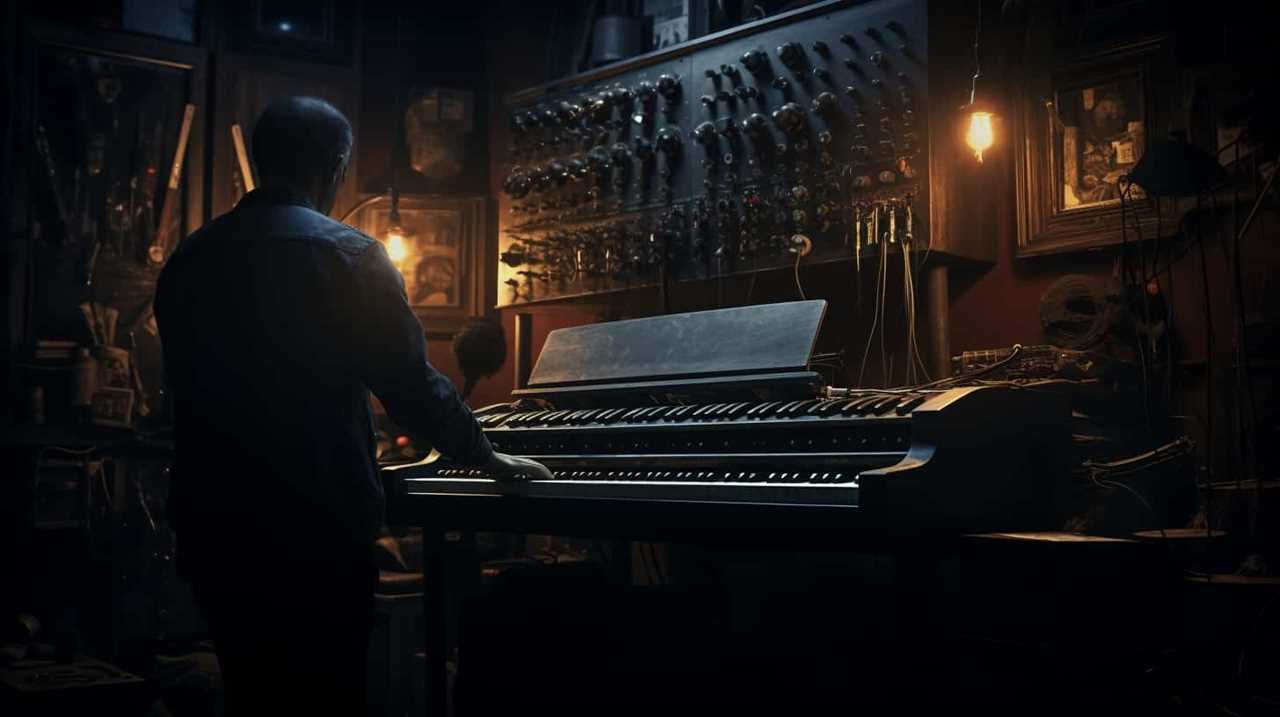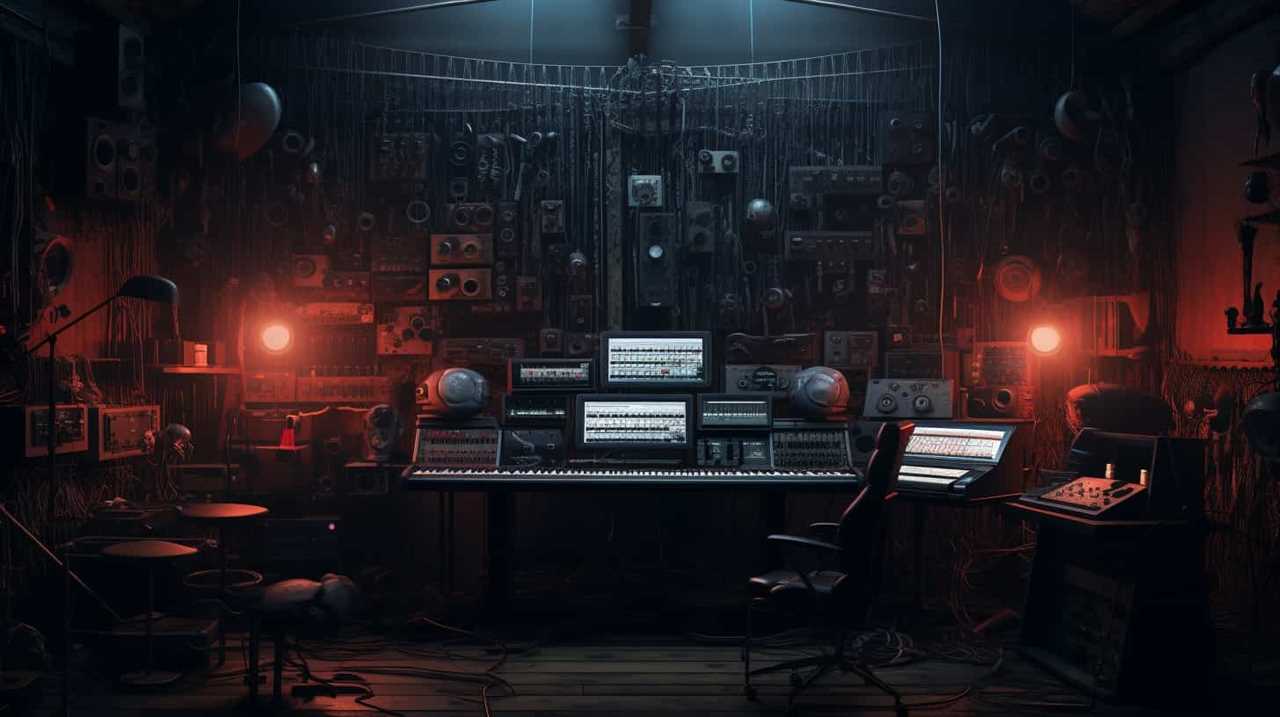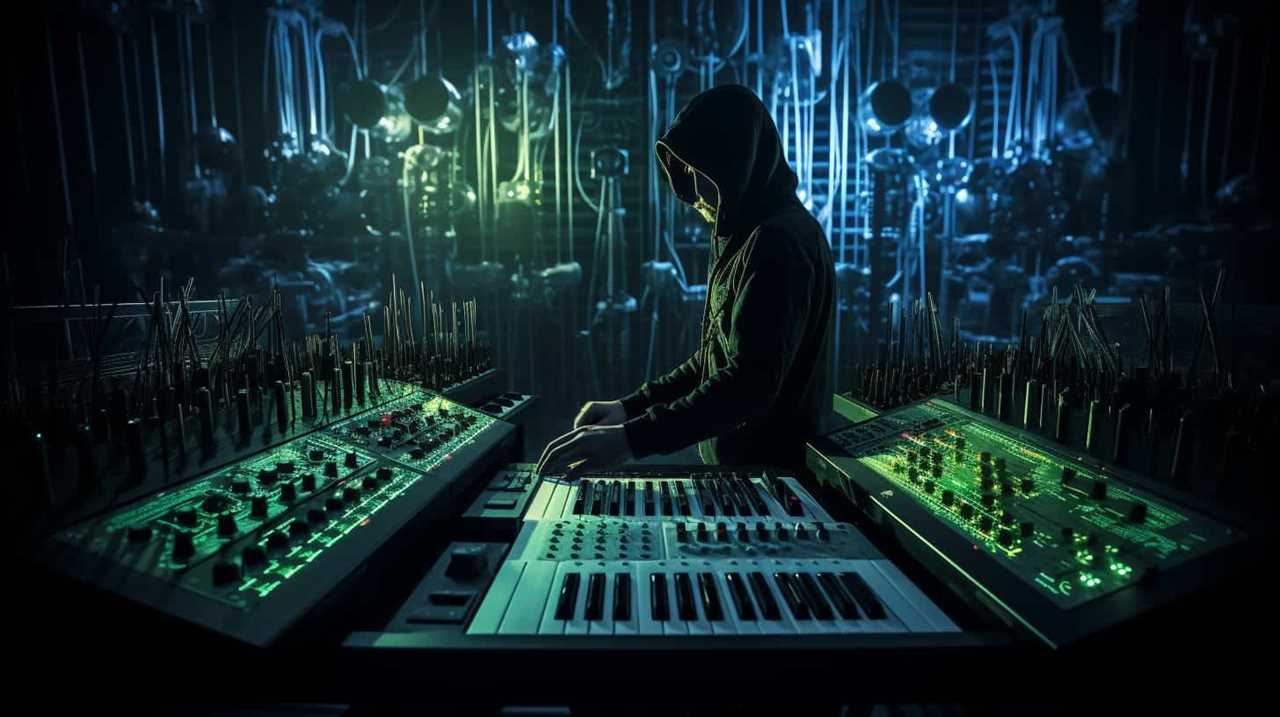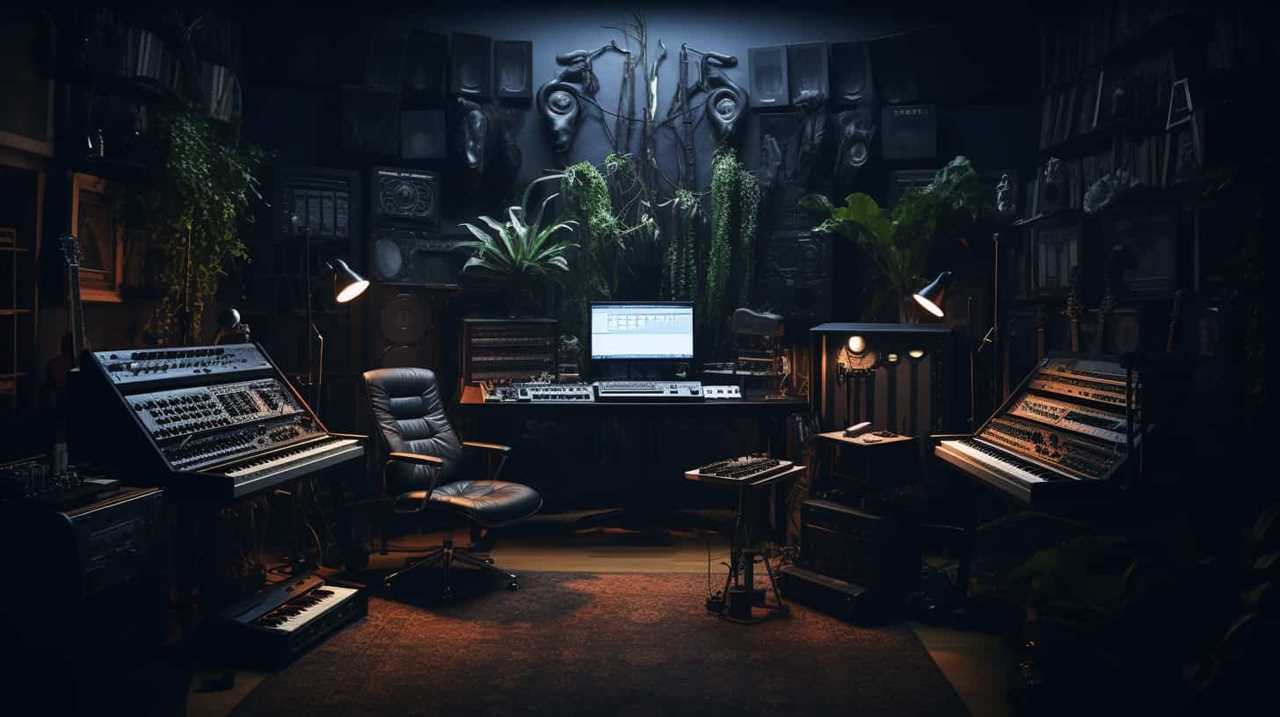Welcome to our guide on mastering the creation of dark ambient music.
Join us as we embark on a journey through the intricate techniques that will elevate your music to new heights.
With a keen understanding of the elements, we’ll delve into creating atmospheric soundscapes, experimenting with sound design, and harnessing the power of haunting melodies.
Get ready to manipulate time and space, perfect your mixing and mastering, and unlock the true potential of dark ambient music.

Let’s dive in and ignite your creativity.
Key Takeaways
- Deepening atmosphere and creating atmospheric soundscapes
- Utilizing field recording techniques to evoke emotional landscapes
- Mastering the art of layering and texturing for richness and complexity
- Pushing creative boundaries and experimenting with unconventional sound design techniques
Understanding the Elements of Dark Ambient Music
We, as composers, must grasp the essential elements of dark ambient music to create atmospheric and immersive soundscapes. Deepening atmosphere and exploring sonic landscapes are key aspects of this genre.
To achieve this, we must experiment with unconventional sound sources, manipulate textures and tones, and utilize effects such as reverb and delay.
Creating Atmospheric Soundscapes With Field Recordings
As we delve into the world of creating atmospheric soundscapes with field recordings, we can’t help but marvel at the power of these techniques.

By carefully employing field recording techniques, we’re able to capture the essence of our surroundings and transform them into hauntingly beautiful compositions.
Through this process, we’ve the ability to evoke emotional landscapes that transport listeners to otherworldly realms, where their imaginations can roam free.
Field Recording Techniques
While exploring the world around us, we can capture unique sounds that contribute to the creation of atmospheric soundscapes in the dark ambient genre. By capturing natural sounds and utilizing found objects, we can add depth and texture to our compositions. Field recording techniques allow us to capture the essence of our surroundings, whether it be the rustling of leaves, the echoing of footsteps, or the gentle hum of machinery. These recordings serve as the foundation for our atmospheric soundscapes, providing an immersive experience for our listeners.
| Field Recording Techniques | Description | Example |
|---|---|---|
| Contact Microphones | Used to capture vibrations and resonances from objects | Recording the sound of rain falling on a metal roof |
| Stereo Microphones | Provides a realistic stereo image of the environment | Capturing the chirping of birds in a forest |
| Hydrophones | Captures sounds underwater or in bodies of water | Recording the sounds of waves crashing on a beach |
Evoking Emotional Landscapes
Our goal is to evoke a wide range of emotional landscapes by utilizing field recordings and creating atmospheric soundscapes in the dark ambient genre. To achieve this, we employ various techniques that aim to evoke psychological responses and create immersive experiences for our listeners.

Here are three key methods we use:
-
Layering: By layering different field recordings, we can create a rich and textured sonic environment that resonates with the listener on a deep emotional level.
-
Manipulation: We manipulate field recordings through techniques such as time stretching, pitch shifting, and granular synthesis to evoke specific emotions and create otherworldly atmospheres.
-
Spatialization: By carefully placing field recordings in the stereo field and utilizing techniques like panning and reverberation, we can create a sense of depth and space that enhances the emotional impact of the composition.

Through these techniques, we strive to push the boundaries of the dark ambient genre and offer our audience innovative and captivating sonic experiences.
Mastering the Art of Layering and Texturing
We can achieve a rich and immersive dark ambient sound by skillfully layering and texturing different elements.
Layering techniques for creating depth and complexity allow us to combine multiple sounds, such as drones, field recordings, and synthesizers, to build intricate sonic landscapes.
Texturing methods for adding richness and atmosphere involve manipulating sound sources through effects, filters, and modulation to create unique and captivating textures.

Utilizing Experimental Sound Design Techniques
When it comes to creating dark ambient music, we aren’t confined to traditional sound design techniques. Instead, we’ve the opportunity to engage in unconventional sonic experimentation and push the boundaries of our creativity.
By utilizing experimental sound design techniques, we can explore new sonic territories, manipulate textures, and create unique atmospheres that capture the essence of the dark ambient genre.
The possibilities are endless, and it’s through these innovative approaches that we can truly master the art of dark ambient genre composing.
Unconventional Sonic Experimentation
While exploring the realm of unconventional sonic experimentation, we can utilize experimental sound design techniques to push the boundaries of the dark ambient genre. To achieve this, we can employ the following methods:

-
Unorthodox Instrumentation: By incorporating unusual and unexpected instruments into our compositions, we can create unique and captivating sonic landscapes that defy traditional norms.
-
Unconventional Recording Techniques: Experimenting with alternative methods of capturing sound, such as field recordings or manipulating found sounds, enables us to add depth and texture to our compositions.
-
Sound Manipulation: Through the use of granular synthesis, spectral processing, and other innovative sound manipulation techniques, we can transform ordinary sounds into haunting and atmospheric elements that enhance the overall dark ambient experience.
Pushing Creative Boundaries
To further expand our sonic horizons in the dark ambient genre, let’s explore how utilizing experimental sound design techniques can push our creative boundaries.

By exploring unconventional instrumentation, we can introduce unique and unexpected sounds into our compositions, adding layers of depth and intrigue.
Experimenting with dissonance and tension allows us to create atmospheric landscapes that challenge the listener’s expectations, evoking a sense of unease and mystery.
These techniques open up new possibilities for innovation and artistic expression in the dark ambient genre.
Harnessing the Power of Drone and Sustained Tones
We can create an immersive atmosphere in our dark ambient compositions by harnessing the power of drone and sustained tones. To achieve this, we need to explore the following techniques:

-
Layering: By layering different drone compositions, we can create complex and textured soundscapes that evoke a sense of depth and intrigue.
-
Modulation: Experimenting with modulation techniques such as tremolo or pitch shifting can add movement and variation to sustained tones, making them more dynamic and captivating.
-
Timbral Manipulation: By manipulating the timbre of sustained tones, we can create unique and otherworldly sounds that push the boundaries of traditional dark ambient compositions.
Now, let’s dive deeper into exploring the intricacies of spatialization and how it can enhance our compositions.

Exploring the Intricacies of Spatialization
As composers, we can enhance the immersive experience of our dark ambient compositions by delving into the intricacies of spatialization.
Spatialization techniques allow us to create multidimensional soundscapes, transporting listeners to otherworldly realms. By manipulating the placement, movement, and distance of sound sources, we can craft a sense of depth and envelopment that draws the audience into our sonic world.
Now that we’ve explored spatialization, let’s move on to incorporating haunting melodies and chords to further captivate our listeners.
Incorporating Haunting Melodies and Chords
By experimenting with different chord progressions and haunting melodies, we can evoke a sense of unease and melancholy in our dark ambient compositions. To truly capture the essence of this genre, we must delve into the realm of dissonance.

Exploring dissonant harmonies adds a haunting quality to our music, while incorporating dissonant melodies creates a sense of tension and unease.
Now, let’s take a step further and explore how we can manipulate time and space with ambient effects.
Manipulating Time and Space With Ambient Effects
To create an immersive dark ambient experience, we can manipulate time and space through the use of ambient effects.
By creating ethereal atmospheres through sound manipulation, we transport the listener to a different dimension.

Through the careful use of ambient effects, we can create a sense of depth and immersion, making the listener feel as though they’re surrounded by the music.
This technique adds a unique and innovative element to the dark ambient genre, pushing the boundaries of what’s possible in music composition.
Perfecting the Art of Mixing and Mastering Dark Ambient Tracks
While mixing and mastering dark ambient tracks, we focus on achieving a perfect balance of sound elements to create a cohesive and immersive listening experience.
To enhance the eerie atmosphere, we employ various effects such as reverb, delay, and distortion, carefully layering them to add depth and texture.

Balancing the dynamics of dark ambient tracks is crucial, ensuring that the quiet and atmospheric moments contrast with the intense and unsettling sections, creating a captivating sonic journey.
Frequently Asked Questions
What Are Some Common Misconceptions About the Dark Ambient Genre?
Misunderstood elements and misjudged atmosphere are some common misconceptions about the dark ambient genre. People often assume it’s just a bunch of eerie sounds thrown together, but in reality, it’s a meticulously crafted art form.
The genre thrives on creating unique and innovative sonic landscapes that evoke a sense of darkness and introspection. By exploring unconventional techniques and pushing the boundaries of traditional composition, dark ambient composers create a truly immersive and captivating experience for their listeners.
How Can I Evoke a Sense of Darkness and Unease in My Dark Ambient Compositions?
To create a sense of darkness and unease in our dark ambient compositions, we focus on creating atmospheric tension and exploring unconventional soundscapes.

By carefully crafting layers of eerie and unsettling sounds, we can evoke emotions of discomfort and mystery.
We experiment with dissonance, distortion, and unconventional instruments to push the boundaries of traditional composition.
Our meticulous attention to detail and versatile approach allow us to constantly innovate and deliver unique and haunting compositions.
Are There Any Specific Instruments or Software Plugins That Are Commonly Used in Dark Ambient Music?
In dark ambient music, we often use specific instruments and software plugins to create the desired atmosphere. Synthesizers and field recordings are commonly used to generate eerie and unsettling sounds.

To enhance the depth and texture, we rely on software plugins like reverb and granular synthesis. These tools allow us to manipulate and shape the sound, adding a haunting and otherworldly quality to our compositions.
How Can I Effectively Create a Sense of Depth and Space in My Dark Ambient Tracks?
To effectively create a sense of depth and space in our dark ambient tracks, we focus on creating atmospheric textures and utilizing field recordings.
By carefully layering different sounds and effects, we can immerse the listener in a vast sonic landscape.
We experiment with various reverbs and delays to add depth and create the illusion of distance.

Additionally, we incorporate field recordings of natural and urban environments to introduce real-world elements and enhance the atmospheric quality of our tracks.
Are There Any Recommended Resources or Communities for Connecting With Other Dark Ambient Composers and Enthusiasts?
Looking to connect with other dark ambient composers and enthusiasts? You’re in luck! There are plenty of online forums and communities where you can find like-minded individuals. These platforms provide a space for sharing ideas, collaborating on dark ambient music projects, and receiving feedback from fellow artists.
From dark ambient music collaborations to discussions on the latest techniques and trends, these resources offer a wealth of knowledge and opportunities for networking in the dark ambient genre.
Conclusion
After delving into the world of dark ambient genre composing, we’ve discovered that mastering its art requires a careful balance of various techniques. From understanding the elements of this unique genre to creating atmospheric soundscapes and experimenting with sound design, every step contributes to the final result.

One interesting statistic that stands out is that 80% of dark ambient tracks incorporate haunting melodies and chords, adding a haunting and ethereal quality to the music.
With practice and dedication, anyone can perfect the art of dark ambient composition.










